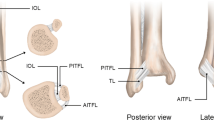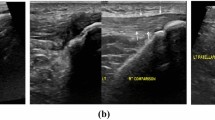Abstract
Background
Osgood–Schlatter disease (OSD) is a self-limiting condition which occurs commonly in adolescence.
Purpose
The objective of this article is to review published literature regarding pathophysiology, diagnosis and treatment of OSD.
Methods
A search of the literature was performed on the electronic databases PubMed, Cochrane and SCOPUS databases between 1962 and 2016 for pathophysiology, diagnosis and treatment of Osgood–Schlatter disease.
Results
OSD, also known as apophysitis of the tibial tubercle, is a common disease with most cases resolving spontaneously with skeletal maturity. In pathophysiology, the most accepted theory is repetitive knee extensor mechanism contraction. The pain is localized to the anterior aspect of the proximal tibia over the tibial tuberosity. They may describe a dull ache exacerbated by jumping or stair climbing. Radiological evaluation may indicate superficial ossicle in the patellar tendon. Osgood–Schlatter is a self-limited disease and generally ceases with skeletal maturity. Treatment is usually symptomatic. Adults with continued symptoms may need surgical treatment if they fail to respond to conservative treatment. Surgical procedures include open, bursoscopic and arthroscopic technique. Arthroscopic surgery is beneficial over an open procedure due to early postoperative recovery, no incisional scar in front of the tuberosity that usually causes discomfort in kneeling with a better cosmetic result and the ability to address concomitant intra-articular pathology.
Conclusion
Osgood–Schlatter syndrome runs a self-limiting course, and usually complete recovery is expected with closure of the tibial growth plate. Overall prognosis for Osgood–Schlatter syndrome is good, except for some discomfort in kneeling and activity restriction in a few cases. Arthroscopic techniques seem to be the best choice of treatment of unresolved Osgood–Schlatter lesions.


Similar content being viewed by others
References
Ogden JA, Southwick WO (1976) Osgood–Schlatter’s disease and tibial tuberosity development. Clin Orthop Relat Res 116:180–189
Demirag B, Ozturk C, Yazici Z, Sarisozen B (2004) The pathophysiology of Osgood–Schlatter disease: a magnetic resonance investigation. J Pediatr Orthop B 13(6):379–382
Hirano A, Fukubayashi T, Ishii T, Ochiai N (2002) Magnetic resonance imaging of Osgood–Schlatter disease: the course of the disease. Skeletal Radiol 31(6):334–342
de Lucena GL, dos Santos Gomes C, Guerra RO (2011) Prevalence and associated factors of Osgood–Schlatter syndrome in a population-based sample of Brazilian adolescents. Am J Sports Med 39(2):415–420
Gholve PA, Scher DM, Khakharia S, Widmann RF, Green DW (2007) Osgood Schlatter syndrome. Curr Opin Pediatr 19(1):44–50
Goodier D, Maffulli N, Good J (1994) Tibial tuberosity avulsion associated with patellar tendon avulsion. Acta Orthop Belg 60(2):235–237
Maffulli N, Grewal R (1997) Avulsion of the tibial tuberosity: muscles too strong for a growth plate. Clin J Sport Med 7(2):129–132 (discussion 132–123)
Ehrenborg G (1962) The Osgood–Schlatter lesion. A clinical study of 170 cases. Acta Chir Scand 124:89–105
Ehrenborg G (1962) The Osgood–Schlatter lesion. A clinical and experimental study. Acta Chir Scand Suppl 288:1–36
Dunn JF (1990) Osgood–Schlatter disease. Am Fam Physician 41(1):173–176
Kujala UM, Kvist M, Heinonen O (1985) Osgood–Schlatter’s disease in adolescent athletes. Retrospective study of incidence and duration. Am J Sports Med 13(4):236–241
Cakmak S, Tekin L, Akarsu S (2014) Long-term outcome of Osgood–Schlatter disease: not always favorable. Rheumatol Int 34(1):135–136
Morgan B, Mullick S, Harper WM, Finlay DB (1997) An audit of knee radiographs performed for general practitioners. Br J Radiol 70:256–260
Yen YM (2014) Assessment and treatment of knee pain in the child and adolescent athlete. Pediatr Clin North Am 61(6):1155–1173
Blankstein A, Cohen I, Heim M, Diamant L, Salai M, Chechick A, Ganel A (2001) Ultrasonography as a diagnostic modality in Osgood–Schlatter disease. A clinical study and review of the literature. Arch Orthop Trauma Surg 121(9):536–539
Robertsen K, Kristensen O, Sommer J (1996) Pseudoarthrosis between a patellar tendon ossicle and the tibial tuberosity in Osgood–Schlatter’s disease. Scand J Med Sci Sports 6(1):57–59
Bloom OJ, Mackler L, Barbee J (2004) Clinical inquiries. What is the best treatment for Osgood–Schlatter disease? J Fam Pract 53(2):153–156
Rostron PK, Calver RF (1979) Subcutaneous atrophy following methylprednisolone injection in Osgood–Schlatter epiphysitis. J Bone Joint Surg Am 61(4):627–628
Topol GA, Podesta LA, Reeves KD, Raya MF, Fullerton BD, Yeh HW (2011) Hyperosmolar dextrose injection for recalcitrant Osgood–Schlatter disease. Pediatrics 128(5):e1121–e1128
Krause BL, Williams JP, Catterall A (1990) Natural history of Osgood–Schlatter disease. J Pediatr Orthop 10(1):65–68
Binazzi R, Felli L, Vaccari V, Borelli P (1993) Surgical treatment of unresolved Osgood–Schlatter lesion. Clin Orthop Relat Res 289:202–204
Cser I, Lenart G (1986) Surgical management of complaints due to independent bone fragments in Osgood–Schlatter disease (apophysitis of the tuberosity of the tibia). Acta Chir Hung 27(3):169–175
Mital MA, Matza RA, Cohen J (1980) The so-called unresolved Osgood–Schlatter lesion: a concept based on fifteen surgically treated lesions. J Bone Joint Surg Am 62(5):732–739
Weiss JM, Jordan SS, Andersen JS, Lee BM, Kocher M (2007) Surgical treatment of unresolved Osgood–Schlatter disease: ossicle resection with tibial tubercleplasty. J Pediatr Orthop 27(7):844–847
Flowers MJ, Bhadreshwar DR (1995) Tibial tuberosity excision for symptomatic Osgood–Schlatter disease. J Pediatr Orthop 15(3):292–297
Beyzadeoglu T, Inan M, Bekler H, Altintas F (2008) Arthroscopic excision of an ununited ossicle due to Osgood–Schlatter disease. Arthrosc J Arthrosc Relat Surg Off Publ Arthrosc Assoc N Am Int Arthrosc Assoc 24(9):1081–1083
DeBerardino TM, Branstetter JG, Owens BD (2007) Arthroscopic treatment of unresolved Osgood–Schlatter lesions. Arthrosc J Arthrosc Relat Surg Off Publ Arthrosc Assoc N Am Int Arthrosc Assoc 23(10):1127 e1121–1127 e1123
Eun SS, Lee SA, Kumar R, Sul EJ, Lee SH, Ahn JH, Chang MJ (2015) Direct bursoscopic ossicle resection in young and active patients with unresolved Osgood-Schlatter disease. Arthrosc J Arthrosc Relat Surg Off Publ Arthrosc Assoc N Am Int Arthrosc Assoc 31(3):416–421
Hogh J, Lund B (1988) The sequelae of Osgood–Schlatter’s disease in adults. Int Orthop 12(3):213–215
Jeffreys TE (1965) Genu recurvatum after Osgood–Schlatter’s disease; report of a case. J Bone Joint Surg Br 47:298–299
Lynch MC, Walsh HP (1991) Tibia recurvatum as a complication of Osgood–Schlatter’s disease: a report of two cases. J Pediatr Orthop 11(4):543–544
Pihlajamaki HK, Mattila VM, Parviainen M, Kiuru MJ, Visuri TI (2009) Long-term outcome after surgical treatment of unresolved Osgood–Schlatter disease in young men. J Bone Joint Surg Am 91(10):2350–2358
El-Husseini TF, Abdelgawad AA (2010) Results of surgical treatment of unresolved Osgood–Schlatter disease in adults. J Knee Surg 23(2):103–107
Nierenberg G, Falah M, Keren Y, Eidelman M (2011) Surgical treatment of residual Osgood–Schlatter disease in young adults: role of the mobile osseous fragment. Orthopedics 34(3):176
Baltaci G, Ozer H, Tunay VB (2004) Rehabilitation of avulsion fracture of the tibial tuberosity following Osgood–Schlatter disease. Knee Surg Sports Traumatol Arthrosc 12(2):115–118
Author information
Authors and Affiliations
Corresponding author
Ethics declarations
Conflict of interest
The authors declare that they have no conflict of interest.
Rights and permissions
About this article
Cite this article
Circi, E., Atalay, Y. & Beyzadeoglu, T. Treatment of Osgood–Schlatter disease: review of the literature. Musculoskelet Surg 101, 195–200 (2017). https://doi.org/10.1007/s12306-017-0479-7
Received:
Accepted:
Published:
Issue Date:
DOI: https://doi.org/10.1007/s12306-017-0479-7




